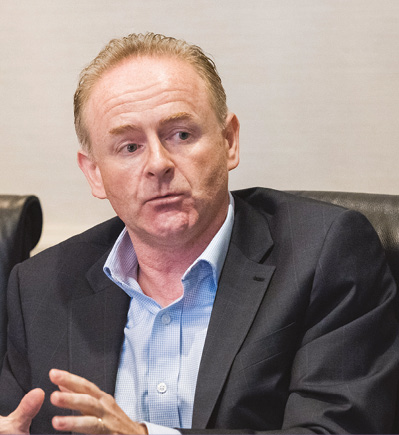Cloud first: enabling shared services


Dell EMC hosted a round table discussion on the role of cloud technology in implementing shared services.
How have cloud services enabled the deployment of shared services?
Barry Lowry
Shared services have been around long before cloud. I started working in shared services in 2004. The principle behind shared services is to achieve savings and better services through economies of scale. The principle of cloud is delivering pooled resources with economies of scale, with consistency and standards. The two sit beside each other really well.
Ken Jordan
Cloud has partially facilitated shared services for us. We are a multi-facetted business with standards through the organisation. To date, security reasons and the lack maturity of many cloud platforms have mitigated against using a lot of cloud services. But we are moving in the direction of cloud, but in a very measured way. We have used cloud principally in NDFA [National Development Finance Agency] via a cloud hosted application environment that is available to a wide customer base. We are also looking to migrate to cloud in a number of other areas. There is scope now for a lot of services provided by the Government Network to look at more cloud services.
Phillip Fischer
Coming from a private sector background, at a global and enterprise level we would have pushed cloud and shared services repeatedly. However, I’m not sure I would link cloud services to shared services – you can still have shared services and self-host. In my experience, it comes down to the business problem and the maturity of the solutions available. From a higher education perspective I would see HEAnet as the go to partner for support in such discussions.
Padraic Doyle
It is primarily about standardisation and that is much more difficult to achieve by yourself. We are moving away from a very standardised environment to cloud based solutions. At this stage cloud services consist of Office 365, Sharepoint and other collaborative tools. There is still an issue of maturity, with challenges around data security and availability – we are a 24/7 operation and any outage would greatly impact our business.
Marion Edwards
I have been involved in shared services for more years than I would like to admit. Technology has always been an enabler in the shared services space – HR, payroll, finance and bespoke applications such as the SUSI grants application. The education sector is very diverse from primary education right through to third level and we have to look at all possible enablers and cloud is certainly one we evaluate. We have been on a shared service journey with HEAnet and its subsidiary EduCampus providing shared ICT services to the Higher Education sector for some time, more recently that journey has expanded to bring other transactional shared services to the education and training sector. In looking at these projects we always look to see if cloud is an appropriate solution for each initiative.
Ronan Byrne
With standardisation and economies of scale, cloud will be a catalyst for shared services, albeit predictability of cost remains a challenge. As a shared service provider for over 20 years now, HEAnet are essentially an aggregator of user demand for the education and research sector. Cloud infers a degree of convergence, as we move to common platforms, and that should play to a shared service aggregation strategy. However, the future choice of cloud platform will very often be decided by the product road-maps of the SaaS companies that you engage with. EduCampus, a new subsidiary of HEAnet since 2015, is a very good example of convergence to a suite of managed SaaS services, as it offers the education sector common SaaS services in relation to HR/Payroll, student administration, student credentials, library and finance systems.
Barry Lowry
Any organisation that thinks they can deliver shared services by simply entering into a cloud technology partnership will end up with a very expensive failed project. The hard work is done before you go to market for the cloud solution. It is about building the culture, getting the processes right and getting them aligned between the partner organisations also addressing the people aspects.
Marion Edwards
Shared services are about process harmonisation and building a common footprint. If you don’t get that right, you will not succeed by simply looking for a technology solution.

“At Dell EMC we see cloud not as a place but as a way of doing IT. At Dell EMC the goal is to offer customers a choice of clouds.
“Dell EMC enables our customers to consume private, hybrid or public cloud on their own terms. Our customers are gaining the flexibility, agility and dynamism of cloud technologies with the control and accountability of traditional infrastructure.
“Our customers are transforming their business processes and delivering significant cost savings and efficiency using on-premise, off-premise and hybrid cloud models. These solutions are underpinned by world class infrastructure, services, software and financial solutions.”
Feargal Duignan
Shared services have been around a long time and the utilisation of cloud is about enablement. All of you are much further into the cloud journey than you probably realise. The facets of cloud are orchestration, multi-tenancy, flexibility and agility. We are now in a digitally transformed economy. Customers of your services expect a level of agility and service based on what they get from their own mobile devices; and we have to match that. There is an expectation that they will get ‘always on’ with good connectivity and be able to transact very efficiently. Cloud gives that agility and it also gives elasticity – for example the register for elections is used once every two years, then it is used exponentially and then suddenly contracts. Cloud offers that hyper-elasticity.
Phillip Fischer
Cloud has led to a transition of the business model. Historically, you made your capital investment and you had your own technical expertise and with fixed capacity levels. Once you go to cloud you move to a P&L service based cost and you don’t have the headaches around the capacity limits and upgrade cycles. Also with the vendors offering the service to other customers the economies of scale achieved should drive down cost.

Phillip Fischer
Ken Jordan
That assumes the vendors can deliver, which is a big assumption these days as they are suffering the same staff turnover as the rest of us. The trouble now is that by going to the cloud you have lost your local knowledge base and if the vendor doesn’t perform that is a real problem. This is one of the big challenges for the next five years. There is an old saying; the hills are always greener far away. There are certainly potentially great benefits but there are also potential problems as well.
Padraic Doyle
Scale will protect you to some extent. If I have two expert vendors in a technology that helps mitigate the risk.
Ken Jordan
That is correct for the big generic solutions in the office environment. But for a multi-faceted business like ours that runs of a number of highly specialised applications, those companies don’t have the resources of the big generic software suppliers. This is a huge challenge for us that we are addressing.
Padraic Doyle
That is an issue around specialised applications whether they are in the cloud or not. We have similar issues. Airport departure control systems are not ten-a-penny and there are only a small number of vendors.

Phillip Fischer
Ronan Byrne
We are establishing a cloud competency within HEAnet to address that expertise need for the sector, particularly around cloud security issues.
Have you any other examples where public sector bodies are using cloud services?
Marion Edwards
We have two examples in the payroll and HR services area. In 2013 we needed to stabilise the existing payroll solutions for the new Education and Training Boards (ETB’s) that merged as entities from the old VEC’s. They couldn’t wait until we had a full transactional shared service solution for the sector. We went for a privately hosted cloud solution which has been operating successfully for the five ETB sites serving about 15,000 payees. This was only a temporary solution to meet the business needs of part of the sector, we are in the process of implementing a full shared service solution for the ETB’s and these entities will be part of the overall solution.
Following on from that we looked at a business case for payroll and HR services for the Higher Education sector and we are now bringing that solution forward. As part of that solution, we are working with EduCampus and they have stabilised the software for the Institutes of Technology using a privately hosted cloud solution. To date we have not used a public cloud solution.
Ronan Byrne
Yes, our subsidiary EduCampus is a very good example of cloud service deployment. The suite of five campus applications originally sat in one data centre location in Dublin. Through competitive public procurement, we now see the services platform migrating from a single data centre location to a variety of cloud platforms across multiple locations. It is interesting to watch the maturity of the cloud services model enabling this migration. Naturally, there are learnings along the way but as a model it is working well.

Ronan Byrne
Barry Lowry
In the US, there are a lot of good examples of shared services based around cloud. Most of the examples I’m familiar with are in Europe, UK and Northern Ireland – where there are some very good examples of shared services moving to the cloud. That is a subtle difference. If you look at Enterprise Shared Services in Northern Ireland, all the users experience what looks like a cloud service because they access it through their browser. But the Oracle backend had not been developed with the provision to exploit the cloud. It is a shared service infrastructure with pooled resources but it isn’t true cloud. The first examples of getting true cloud in Northern Ireland were some of the hosting services where they had to wait for the development of systems that could benefit from the orchestration capabilities of the on-premises government cloud model and that reflects some of Ken’s issues – that is a challenge for government as they use very specific systems. You can’t recruit a company for their expertise, say for an aviation or agriculture system, and then expect those companies to be also world-class in the provision of code on a cloud platform. It is a big jump at this moment in time, but no doubt that is where things will evolve to. The next generation of HCM and ERP systems are going to be able to fully exploit the cloud.
What factors do you take into account when deciding between public, private and hybrid cloud services?
Feargal Duignan
There are now many instances where there is an ambition to bring services together. One of these is the recent example of local authorities, which had come about due to budget constraints and the commonality of service provision. They want to band together to provide their own cloud service and deliver services to each of the local authorities themselves. One of the struggles they have is articulating that message and determining the ownership of that within the current public procurement procedures.
Barry Lowry
Trying to procure by consortium though the European Journal is fraught with difficulty. When you look at successful shared services, they sorted out the organisation, the culture, the rules and processes in advance. In Northern Ireland, Enterprise Shared Services is the procurement authority for the Northern Ireland public sector and the budget owner. There one organisation can spend several million on a technology upgrade as it has already worked out how that money will be recovered through charges. Five or six organisations trying to work together to buy something and then trying to work out how they will divide out the costs and who is responsible for the contracts is a very difficult way to approach a shared service.
Feargal Duignan
Where are we in Ireland in taking the correct approach?
Barry Lowry
In Government, the National Shared Services Organisation (NSSO) has been established with the legal framework to do that. The technology side has come to the show a little later but we are getting there with things like Government Network. By the end of the Autumn we will have a very clear roadmap on how we approach this.
Marion Edwards
Shared services in the Irish public sector is not as mature as in other jurisdictions. The maturity of the model is also much more advanced in the private sector.
We take many factors into account when we evaluate the possible solutions for our shared service projects. We also take guidance in relation to public procurement and other matters so that the long-term solution meets the needs of the sector.
Barry Lowry
Ireland is also very different from say London or parts of the US, in that a lot of legacy exists within current systems and a lot of the powerhouse systems in the public service will not necessarily run more efficiently or cheaply in a cloud model.
Another aspect in the Irish public service is the strength of the internal capability. If you have people with experience in infrastructure and the capability to develop an on-premises cloud model, then you should exploit that because infrastructure people don’t readily retrain as development architects or similar roles. One of the strengths of the Irish public service is the strength of that internal capability and that should be exploited.
Padraic Doyle
I would acknowledge that but my challenge is maintaining that strength over time. I am actively trying to migrate those people into cloud technologies so that they will still exercise their infrastructure skills but in different ways. You need to be careful as the skills issue can quickly catch up on you.
Also, when you go to these shared services models, or indeed when purchasing cloud services generally, the assumption that ‘with the internet the old rules have changed’ – they haven’t. But the pressure will be much more on process and usage design. We can throw applications at users but if no one is educating them in how to use them effectively any efficiencies will not be achieved. We need to also educate the consumers of any shared service.
Marion Edwards
There are limitations in public procurement but it does bring a lot more due diligence up front than you would see in the private sector – where someone has a good idea, brings it to the management team and gets approval and then runs with it in a ‘ready, fire, aim’ approach. The company may then be stuck with the wrong service or wrong contract. The OGP [Office of Government Procurement] model mitigates against that happening in the public service but it can be challenging to meet all stakeholder requirements in one solution. In a sector as diverse as education, it can be difficult to find procurement solutions that work for a large university as well for the small two-teacher school.
Ronan Byrne
It is interesting to view public procurement of cloud services as a shared service. Our experience around brokering cloud procurements, particularly IaaS, is that it can be difficult to get significant engagement with the big players at a local level. However, by collaborating with our fellow education networks across Europe, we have established a pan-European IaaS framework that serves an aggregated European education sector user base of 50 million users, delivering significant commercial and service level benefits over and above what could have been achieved at a national level.
How have security issues and GDPR impacted the use of cloud services?
Feargal Duignan
The decision making in the public sector is not whether it is cloud or not, it is which cloud and what defines that is, firstly security and data governance and then cost. GDPR has been one issue that the public sector has been looking at closely over the past year but I’m still not sure there is a clear public service approach to governance cross the whole sector. Some public bodies are very advanced and others not so much. GDPR is like shared services in that it is a process issue and not a technical issue per se. Cloud and software can enable GDPR but it is primarily a process issue.
Barry Lowry
There are a lot of myths around government and GDPR. Government can’t have one composite answer to GDPR. Each department is a separate legal entity which must have its own process and structure, including data [protection officer, privacy impact assessment process etc. What we can do is address the complexities around issues such as: how do you know what data is held against you? How is that data held? And how can it be corrected? A large part of our ICT strategy is focused on that and it covers how data is shared in line with GDPR.
The other myth is that government won’t use cloud because of security concerns. That is not true. The issue with government is one of control. The big concern is that the “once every two year” outage that even the big players can have. If that happens the day before the Budget or if welfare couldn’t be paid just before Christmas, that would be disastrous. Where would we be in the pecking order to get our service restored? The current government model gives senior officials and ministers something they value greatly and that is control.
Feargal Duignan
Is there also a data sovereignty issue? Particularly for public bodies such as NTMA?
Ken Jordan
We insist that any economic data is held within the European Economic Area. We have an ICT security strategy and a specialist ICT security team. It is one of our top risks. We have a structured GDPR programme and we have the advantage over many other organisations, particularly smaller businesses, of having a well-developed and mature data protection regime.

Ken Jordan
What one area will you focus on when implementing cloud services?
Feargal Duignan
Focus on the breath of the benefits rather than on one area. Look at the key enablers from using cloud: agility, flexibility and orchestration which will help you deliver your services and keep an open mind to what is possible. Cloud is not a location – be it Public, Private or Hybrid – it is more a destination, a way of doing business. There’s an enormous wave of transformation occurring with all data and it does not reside in all one place. This transformation is informing better decisions and managing the data effectively is where organisations will need to focus their cloud strategy.
Ronan Byrne
Building up our cloud competency will be very important for us. Our end goal being a cloud technology assessment service that enables comparison across cloud options and cloud vendors, encompassing commercial, technical, security, and data governance issues.
Marion Edwards
We will be looking at our shared services plan as a whole and at the various solutions across the sector. For each solution we will look at all technology solutions and models. Data security will be a key factor.
Padraic Doyle
For us business intelligence (BI) is now a key part of any project. In the same way we add 10 per cent for security, we now add 10 to 15 per cent for BI. If we don’t, the demand for it comes once the system goes live. The BI stack in the cloud is becoming more mature and there is an increasing business appetite for data analytics. The analytics available from cloud services are probably going to exceed what you can provide yourself for the same cost.
Phillip Fischer
In higher education variability and flexibility are key aspects. As the academic year runs the demand is not linear and in such a world cloud services can address that in a cost effective manner.
Ken Jordan
We will do two relatively easy things. Migrate Sharepoint and CRM into the cloud with secure connections through the Government Network. A number of specialist business systems will also migrate to the cloud. More difficult things include some new emerging technologies such as hyper-converted infrastructure (HCI). This will change the economics of infrastructure fundamentally. It will be a game changer and will compete with some cloud elements.
Barry Lowry
Two main things. The first is to build out the hydrid cloud journey map which includes processes. Secondly, we will be developing the roadmap to replace the PeopleSoft HCM system and that will confront head on the functionality capability of the cloud-based solutions, which is where the industry is going, with the “comfort” of the on premise approach. That is going to be a major challenge for government.

Barry Lowry
Ronan Byrne
 Ronan Byrne is Chief Technology Officer at HEAnet with responsibility for Strategic Planning, Network Development, Schools Connectivity, Identity Management, and Brokerage programmes. Ronan has a successful track record of large-scale ICT programme delivery across Education, Government, Retail, Financial Services and Aviation. Previous employers include Fujitsu, Via Networks, ICL and Aer Lingus.
Ronan Byrne is Chief Technology Officer at HEAnet with responsibility for Strategic Planning, Network Development, Schools Connectivity, Identity Management, and Brokerage programmes. Ronan has a successful track record of large-scale ICT programme delivery across Education, Government, Retail, Financial Services and Aviation. Previous employers include Fujitsu, Via Networks, ICL and Aer Lingus.
Padraic Doyle
 Padraic Doyle holds the position of VP Technology in daa. He is responsible for leading all aspects of IT delivery and technology strategy for daa. He has previously held CIO and senior IT management roles with Payzone Group, Gulf Air, Emirates and Aer Lingus.
Padraic Doyle holds the position of VP Technology in daa. He is responsible for leading all aspects of IT delivery and technology strategy for daa. He has previously held CIO and senior IT management roles with Payzone Group, Gulf Air, Emirates and Aer Lingus.
Feargal Duignan
 Feargal Duignan is Sales Director for Public Sector in Dell EMC on the island of Ireland. He has responsibility for all Storage, Converged, Hybrid, Compute and End User solutions in the Public Sector. His focus is on delivering technology solutions to Dell EMC customers in education, health, central and local government in the Republic of Ireland and Northern Ireland. He has been working in the sector for the last 18 years and has delivered customer solutions including public, private and hybrid cloud, analytics and big data.
Feargal Duignan is Sales Director for Public Sector in Dell EMC on the island of Ireland. He has responsibility for all Storage, Converged, Hybrid, Compute and End User solutions in the Public Sector. His focus is on delivering technology solutions to Dell EMC customers in education, health, central and local government in the Republic of Ireland and Northern Ireland. He has been working in the sector for the last 18 years and has delivered customer solutions including public, private and hybrid cloud, analytics and big data.
Marion Edwards
 Marion Edwards is Shared Services Advisor to the Department of Education and Skills, developing the sector’s shared services strategy and driving its implementation. A financial controller with over 20 years’ private sector experience in shared services /outsourcing, in industries such as gas, electricity, mail, telecommunications and medical technology. She has worked in Ireland, the Netherlands and Australia.
Marion Edwards is Shared Services Advisor to the Department of Education and Skills, developing the sector’s shared services strategy and driving its implementation. A financial controller with over 20 years’ private sector experience in shared services /outsourcing, in industries such as gas, electricity, mail, telecommunications and medical technology. She has worked in Ireland, the Netherlands and Australia.
Phillip Fischer
 Phillip Fischer is the recently appointed Chief Information Officer for University College Dublin. Phillip is responsible for university-wide IT Services including academic and administrative systems, research IT, teaching and learning technologies, and UCD web services. With a background as an ICT change leader, Phillip has over 25 years of experience in delivering projects and services across a large range of industries and has a consistent track record of supporting organisational strategy with long term ICT strategies in complex organisational environments.
Phillip Fischer is the recently appointed Chief Information Officer for University College Dublin. Phillip is responsible for university-wide IT Services including academic and administrative systems, research IT, teaching and learning technologies, and UCD web services. With a background as an ICT change leader, Phillip has over 25 years of experience in delivering projects and services across a large range of industries and has a consistent track record of supporting organisational strategy with long term ICT strategies in complex organisational environments.
Ken Jordan
 Ken Jordan is a Deputy Director and Head of ICT for the National Treasury Management Agency. Ken has worked previously in senior ICT roles for Qatar Petroleum, Bord Na Mona, Digital International and the Irish Department of Energy. Ken is a Fellow of the Irish Computer Society and holds Primary and Master’s degrees in Computer Science from Trinity College Dublin.
Ken Jordan is a Deputy Director and Head of ICT for the National Treasury Management Agency. Ken has worked previously in senior ICT roles for Qatar Petroleum, Bord Na Mona, Digital International and the Irish Department of Energy. Ken is a Fellow of the Irish Computer Society and holds Primary and Master’s degrees in Computer Science from Trinity College Dublin.
Barry Lowry
 Barry Lowry is the Government’s Chief Information Officer. He spent almost 35 years in the Northern Ireland Civil Service (NICS) on work ranging from the programming of mainframe computers to operating as a team leader in the design of client server systems. For the five years prior to his appointment, Lowry was the director who oversaw the establishment of ICT shared services in NICS. He also operated as the Head of Profession for ICT. In 2011 he was voted the Northern Ireland IT Professional of the Year by his associates.
Barry Lowry is the Government’s Chief Information Officer. He spent almost 35 years in the Northern Ireland Civil Service (NICS) on work ranging from the programming of mainframe computers to operating as a team leader in the design of client server systems. For the five years prior to his appointment, Lowry was the director who oversaw the establishment of ICT shared services in NICS. He also operated as the Head of Profession for ICT. In 2011 he was voted the Northern Ireland IT Professional of the Year by his associates.

Dell EMC hosted a round table discussion on the role of cloud technology in implementing shared services.





